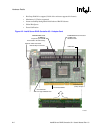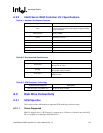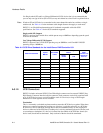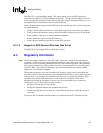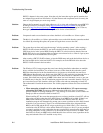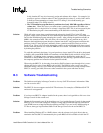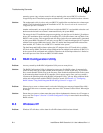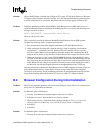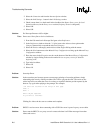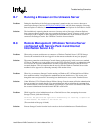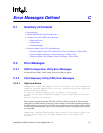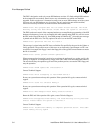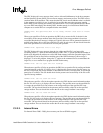
B-4 Intel® Server RAID Controller U3-1 User’s Manual Rev 1.0
Troubleshooting Scenarios
operating system. Any volumes created on drives attached to the second SRCU31 will not be
recognized by the NT installation program and therefore NT cannot be installed on those volumes.
Solution: The workaround to this is to have only one SRCU31 installed (the one that hosts the volume upon
which NT will be installed) during the installation of NT. The second card can be inserted and
configured after NT is installed.
Another workaround is to swap the PCI slots in which the SRCU31’s are installed so that the card
that houses the desired boot volume is enumerated first by the system BIOS.
The reason for the NT installation program recognizing only the first card is that the I
2
O miniport
driver (NT installation driver used only for installing NT to a RAID volume) can only bind to one
SRCU31 card at a time. This recognized card will always be the first one enumerated by (presented
to) the system BIOS. Therefore NT will only see one SRCU31 until the miniport driver is replaced
with the block storage OSM (after install). After NT and the Intel Integrated RAID software has
been installed, NT is able to see all SRCU31’s installed in the system.
The Intel Integrated RAID software replaces the NT miniport driver (NT install driver) with the
NT block storage OSM. The block storage OSM can bind to multiple cards and thus all SRCU31’s
in the system can be configured and controlled. Therefore, the I
2
O miniport behavior is limited to
the install process of the card on an SRCU31 RAID volume.
B.4 RAID Configuration Utility
Problem: An array created by the RAID Configuration Utility uses too many drives.
Solution: The RAID Configuration Utility is designed to create your first RAID volume. It automatically
creates an array using up to eight available disks and places a volume on the array. If you would
like a certain number of disks to be in the first array, then disable the additional disks in the system
by disconnecting them from the SCSI controller or their power supply. Once you have created a
volume on the remaining disks using RAID Configuration Utility, you may bring additional disks
online and configure them with the SRCU31 Storage Console. See Section 4.3, “Configuring
RAID Volumes Using Intel® Integrated RAID Storage Console” on page 4-12.
Problem: When trying to create a volume name I receive the following error message: Internal Error 4016 -
please report this error to customer support, then error 4105: Volume Creation Failed. What might
be wrong?
Solution: Ensure that you create a volume name that starts with an alphanumeric character A to Z in upper or
lower case. See Chapter 2, Section 2.2, RAID Configuration Utility for more details about naming
RAID volumes.
B.5 Windows NT
Problem: Windows NT still shows a drive letter for a RAID volume which has been deleted.



